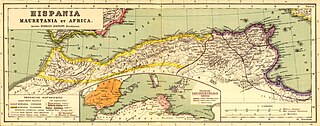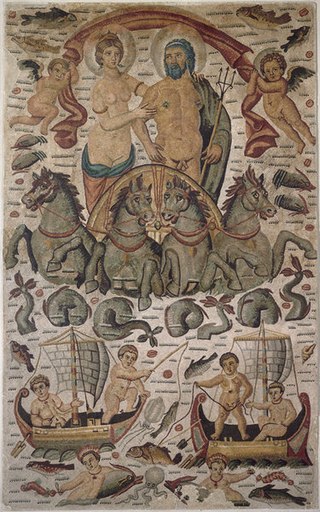
Mauretania is the Latin name for a region in the ancient Maghreb. It stretched from central present-day Algeria westwards to the Atlantic, covering northern present-day Morocco, and southward to the Atlas Mountains. Its native inhabitants, of Berber ancestry, were known to the Romans as the Mauri and the Masaesyli.
Articles related to Algeria include:

Siga was a Berber and Roman port located near what is now Aïn Témouchent, Algeria. Under the Roman Empire, it was part of western Mauretania Caesariensis, bordering Mauretania Tingitana.

Cirta, also known by various other names in antiquity, was the ancient Berber and Roman settlement which later became Constantine, Algeria.

Djémila, formerly Cuicul, is a small mountain village in Algeria, near the northern coast east of Algiers, where some of the best preserved Roman ruins in North Africa are found. It is situated in the region bordering the Constantinois and Petite Kabylie.

Thagaste was a Roman-Berber city in present-day Algeria, now called Souk Ahras. The town was the birthplace of Saint Augustine.

Mauretania Sitifensis was a Roman province in Northwest Africa. The capital was Setifis.

Milevum was a Roman–Berber city in the Roman province of Numidia. It was located in present-day Mila in eastern Algeria.
Icosium was a Phoenician and Punic settlement in modern-day Algeria. It was part of Numidia and later became an important Roman colony and an early medieval bishopric in the casbah area of actual Algiers.

Tobna, also known by the ancient names of Tubunae or Thubunae, is a ruined former city in Batna Province of Algeria, located just south of the modern city of Barika. From this position, it once controlled the eastern part of the Hodna region, while M'Sila did the west. It flourished from the time of the Roman Empire through the Islamic Middle Ages, until it was sacked and destroyed by the Banu Hilal in the 11th century, after which it was finally abandoned.

Mesarfelta was a Roman–Berber town in the province of Numidia. It was also a bishopric that is included in the Catholic Church's list of titular sees.

Quiza also known as Vuiza (Βούϊζα), which Pliny the Elder called Quiza Xenitana, was a Roman–Berber colonia, located in the former province of Mauretania Caesariensis. The town is identified with ruins at Sidi Bellater, Algiers.

Caesarea in Mauretania was a Roman colony in Roman-Berber North Africa. It was the capital of Mauretania Caesariensis and is now called Cherchell, in modern Algeria. In the present time Caesarea is used as a titular see for Catholic and Eastern Orthodox bishops.

Madauros was a Roman-Berber city and a former diocese of the Catholic Church in the old state of Numidia, in present-day Algeria.
Tigisis, also known as Tigisis in Mauretania to distinguish it from another Tigisis in Numidia, was an ancient Berber town in the province of Mauretania Caesariensis. It was mentioned in the Antonine Itinerary.
The diocese of Siccesi is a suppressed and titular see of the Roman Catholic Church.
Timici was a Phoenician, Numidian, and Roman town located in present-day Ain Matboul, Algeria .

Tamada was an ancient Roman–Berber civitas in the province of Mauretania Caesariensis. The town lasted through the Byzantine Empire, Vandal Kingdom and Roman Empire into late antiquity, until at least the Muslim conquest of the Maghreb in the 7th century.

The Limes Mauretaniae was a portion of a 4,000-kilometre (2,500 mi) Roman fortified border (limes) in Africa approximately 100 kilometres (62 mi) south of the modern day Algiers.
The gens Tannonia was an obscure plebeian family at ancient Rome. Few members of this gens are mentioned in Roman literature, but many are known from inscriptions.















